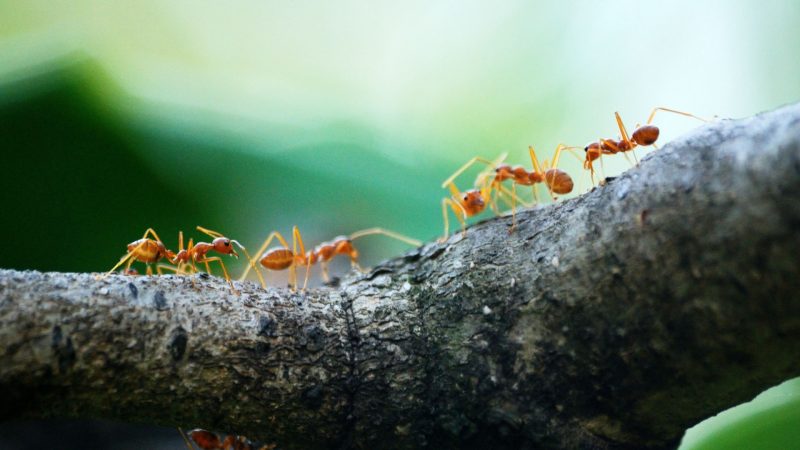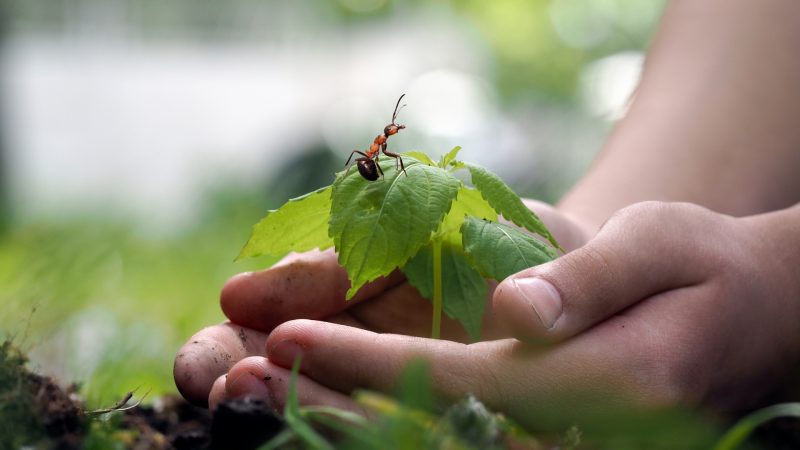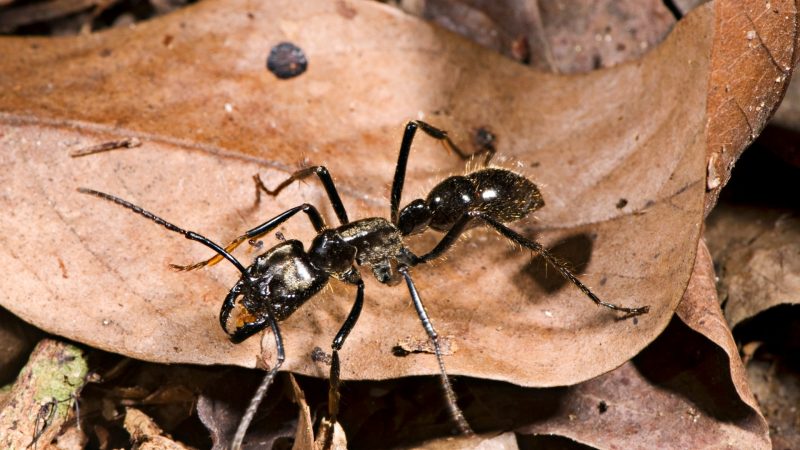Ants are ubiquitous. They are the most dominant and most widely distributed social insects on Earth. Thus, it comes as no surprise that we get to encounter ants almost anywhere we go.
How many ants live on Earth? A conservative estimate of the ant population is about 20 quadrillion ants on Earth. At present, more than 15,700 ant species and subspecies have been described, making them the most species-rich group of social insects.
The success of ants has piqued the interest of many scientists, resulting in a wide array of exploration about this particular group of insects. This article will explore interesting facts about ants that scientists have discovered after decades of research.
How Many Ants Exist in the World?

As of this writing, there are about 20 quadrillion ants in the world. The population of ants was estimated to be ten thousand trillion as early as 1964 based on a one percent estimate of the number of all living insects on Earth at any given moment.
Currently, ant specialists have identified 300 genera, 21 extant subfamilies, and over 15,700 species of ants, which vary greatly in behavior and morphology. The list is far from being complete, and this number could reach as high as 30,000, given the large portion of unrecognized and undescribed species.
Cataloging can be challenging and would depend on the level of taxonomic research that has been employed. As taxonomic tools and knowledge advance, more information about ants gets unraveled; thus, more ant species will be discovered, recognized, and formally described in the near future.
Related: How Many Types of Ants Are There: Ant Identification Chart
Which Continent Has the Most Ants?

Following the classical partitions, the seven biogeographic regions include Nearctic, Neotropic, Palaearctic, Afrotropic, Indomalaya, Australasia, and Oceania. Due to its high endemism level, Madagascar was separated from Afrotropic, forming a separate region, Malagasy.
Among the seven biogeographical realms, the Neotropic and Indomalaya host the largest number of ant genera with 128 identified lineages. In terms of endemicity, 52 or 41% of the 290 identified genera were endemic to the Neotropic region.
| Biogeographic Region | Total Genera | Endemic | Endemic Genera (%) |
| Neotropic | 128 | 52 | 41% |
| Indomalaya | 128 | 24 | 19% |
| Australian | 115 | 30 | 26% |
| Afrotropic | 88 | 31 | 35% |
| Palearctic | 82 | 10 | 12% |
| Malagasy | 47 | 5 | 11% |
| Nearctic | 73 | 2 | 3% |
| Oceania | 44 | 1 | 2% |
Which Country Has the Most Number of Ants?
Currently, Australia holds the record for hosting more than 4,000 known species of ants, of which over 1,000 species are native to the region. Specifically, Queensland is filled with a wide range of ant species.
Which Continent Is the Only One to Not Have Ants?
Ants are present in every continent except Antarctica, where the mean annual temperature ranges from -10°C to -60°C. Likewise, no ant species have been recorded in Greenland and Iceland.
Temperature is one of the major factors influencing the distribution of ants since they have difficulty tolerating cold and wet climates. Greenland belongs to the Arctic, where the mean temperature peaks at 10°C. Similarly, most parts of Iceland have an average temperature close to 10°C during summer.
Related: Do Ants Poop? | Facts and Myths Explored
What Is the Ratio of Ants to Humans in the World?

The number of ants on Earth was estimated to be around ten thousand trillion. Since today’s population is around 8 billion people, this suggests that there are approximately 2.5 million ants per person.
Are All the Ants as Heavy as All the Humans on Earth?
Ants are tiny creatures with lengths as small as 1/16 inches (2 mm). Their weight also varies depending on the species. On average, a worker ant would weigh 1 to 5 milligrams.
Consequently, the combined weight of ten thousand trillion ants would be 12 million tons, whereas 7.9 billion humans would weigh approximately 390 million tons. Thus, the total mass of humans on Earth outweighs the total mass of ants.
Related: Ant Size Chart | A Simple Size Comparison Guide
How Do You Weigh an Ant?
- Step 1: Take a container and weigh it using an electronic balance.
- Step 2: Place a known number of ants inside the container and measure the new weight.
- Step 3: Subtract the weight of the empty container from the combined weight of the ants and the container.
- Step 4: Divide the resulting weight by the number of ants to get the average weight of each ant.
How Long Have Ants Been on the Earth?
Understanding the origin of ants is a continuously evolving area of research. Over 100 million years ago, in the Cretaceous era, ant fossils were discovered. Nonetheless, the oldest definitive group of ants has identified 95 million years ago in the Late Cenomanian.
On the other hand, divergence dating methods suggest that ants may have originated either 140 to 168 million years ago or 115 to 135 million years ago.
Throughout these studies, ants were revealed to have shared a common ancestor with bees and wasps. Additionally, their evolution to modern ants was also revealed to be predominantly influenced by their nesting and foraging habits.
Related: Are Ants the Smartest Insect? | It depends!
Biggest Ants on Earth

With a total body length ranging from 3 to 4 centimeters, the largest ant species in the world is the Dinoponera gigantea. Generally, ants of the genus Dinoponera, commonly referred to as giant Amazonian ants, are regarded as the largest in the world. They can be found strictly throughout South America.
Historically, Formicium giganteum were the largest ants to have ever lived on Earth. It is a giant carnivorous ant with body lengths of about 5.5 centimeters and wingspans of about 13 centimeters. These extinct ants were known to arise approximately 50 to 55 million years ago in the early Eocene.
Interesting Facts About Ants
1. The Asian Weaver Ant Can Carry 100 Times Its Body Weight
While some ant species are known to carry more than 10 to 50 times their body weight, weaver ants (Oecophylla smaragdina) can carry 100 times their body weight. These ants can be found throughout Australia, Southeast Asia, and the Western Pacific Islands.
Weaver ants are arboreal species known for their unique nesting behavior. Worker ants construct nests by weaving together leaves of different shapes and sizes, which are fastened together using larvae-produced silk.
Moreover, these strong neck muscles not only allow worker ants to carry preys that are heavier and larger than their body but also to maintain balance while bringing their prey or food fragments back to their nests.
Related: How Strong Are Ants? | Incredible Strength Explained
2. Ants Can Live For Decades
Ants, specifically queens, could live for more than a decade. Lasius niger, commonly known as the black garden ant, holds the longest lifespan for an ant in a laboratory. The queen of the black garden ants was held in captivity for 28 years and 9 months by a German entomologist named Hermann Appel.
On the other hand, queen ants of the species Pogonomyrmex owyheei, or the Western harvester ant, were estimated to live for 14 to 30 years in the field. Although the worker ants die off, the colony lives on, along with its queen.
Related: How Long Do Ants Live | Fascinating Insight into Their Life Cycle
3. Ants Can Survive for an Entire Day Under Water
Like other animals, ants need oxygen to survive. Therefore, it is likely for them to get drowned when their nests get flooded and their colonies get submerged for long periods.
However, ants from the genus Formica, also known as wood or field ants, can survive for up to two weeks of being submerged underwater. This occurrence is possible because ants will enter an anesthetized state in which their oxygen intake is decreased by up to 20% of their regular consumption.
In addition, an experiment performed as far back as 1904 revealed that black carpenter ants (Camponotus pennsylvanicus) could live and fully recover after being submerged for eight days.
Related: How to Get Rid of Black Ants | Natural and Pesticide Solutions
4. Ants Don’t Have Lungs
Unlike humans and other animals, ants do not have lungs. Instead, oxygen gets delivered to their bodies by passing through the small openings on their thorax and abdomen. These openings are called spiracles.
Depending on the species, ants may have nine or ten pairs of spiracles that allow the entry of oxygen and exit of carbon dioxide from their bodies. Once oxygen enters the spiracles, it diffuses throughout an ant’s body through the respiratory ducts called tracheal tubes.
5. Ants Are Farmers
Leaf cutter ants (Atta cephalotes) are farmers who can grow their food in their nests through their mutualistic relationship with fungi. This relationship allows ants to survive, maintain their colony, and for the queen to establish more colonies.
While humans were believed to have started farming 12,000 years ago, ants have been farming fungus for 45 to 65 million years, making them the first and the oldest farmers on Earth. As with humans, this represented the transition from being hunter-gatherers to subsistence farmers.
Related: How to Get Rid of Leaf Cutter Ants | Proven and Effective Solutions
The Farming Process
- Step 1: Workers of leaf cutter ants will start searching for suitable leaves. They slice using their powerful mandibles and pull the leaves using their front feet. At the same time, they will send vibrations towards their nearby nestmates for help.
- Step 2: The harvested leaf fragments are transported back to their nests. Ants will return to their nests by following a pheromone trail created by other ants to mark their path. Workers and carriers go along the trails, reinforcing pheromone marks to attract more ants.
- Step 3: A small group of ants called minims will grind the leaf fragments, which are used as the substrate for the fungi. Growing fungi would require a constant supply of leaves, which the worker ants deliver.
- Step 4: As the fungi grow, it produces nutrient-rich gonglydia (hyphal swellings), which the ants harvest and gets fed to the ant colony.
In a day, hundreds of thousands of leaf fragments are fed to the fungi garden. After mating with multiple males, the young leaf cutter ant queen will leave the nest carrying fungal spores, which it would use to start a new fungi garden as it creates a new colony.
6. Ants Have Two Stomachs
Eusocial insects such as ants possess two stomachs: a crop and a real stomach.
- Crop (social stomach): Holds the food that ants share among their nestmates.
- Real stomach: Digestion of liquid food occurs.
Both of these stomachs are located in the ant’s abdomen and separated by the proventriculus, which acts as a one-way valve, preventing the backward flow of liquid.
Adult ants have narrow petiole; thus, large chunks of food could not pass through. These are then spitted out and fed to the larvae. The liquid food that the ants have not absorbed gets stored in the crop.
Ants distribute food among their nestmates through regurgitation of liquid from the crop to the esophagus in a process called trophallaxis. Some ant species have highly expandable crops that serve as living food storage for the colony. Depending on the size, the stored liquid could last for several months.
7. Ants Are as Old as Dinosaurs
Dinosaurs are believed to have lived in the Mesozoic era, which encompasses three geologic periods (Triassic, Jurassic, and Cretaceous). On the other hand, ants were believed to have originated in the late Jurassic or early Cretaceous. This suggests that dinosaurs and ants have lived at the same time.
Between the late Cretaceous period (66 million years ago) and the early Paleogene, dinosaurs went extinct due to a meteorite impact that has caused drastic environmental changes. Meanwhile, the primitive ancestor ants were able to survive, evolve, and diversify into modern lineages.
8. Ants Can Become Zombies
The parasitic fungus Ophiocordyceps unilateralis infects an ant’s body and turns it into a ‘zombie’ ant. Once inside the ant’s body, the parasite does not infect the ant’s brain. Instead, it takes control of the ant’s muscles, causing ants to lose control of its body.
Infection is said to develop 2 to 3 weeks after the ant has been infected. In its final act, the ant would climb up nearby vegetation and bite down the vein on the underside of a leaf. It remains in this position until it dies. This behavior is often referred to as the ‘death grip.’
Soon after, a stalk emerges from the head of the ant containing spores of the parasitic fungus. The fungus spreads spores on the forest floor, infecting more foraging ants.
9. Colonies Are Far Larger Than the Typical Ant Farm
An ant colony begins when a young queen leaves its nest to find a new nesting site and form colonies of its own. The colony grows and matures as new workers are produced. While some mature colonies only consist of less than 100 adult ants, other ant colonies can have hundreds of millions of adult ants.
In Japan, the native ants (Formica yessensis) in the Ishiraki coast were found to have 307 million adult workers and over 1 million queens in approximately 45,000 nests. In the US, a supercolony of argentine ants (Linepithema humile) stretches 600 miles from Northern California to the Mexican border.
Various research showed that other than resource availability, preferred nesting sites also influence the size of a colony. For instance, ant species whose nesting habits prefer rotting logs and decaying wood are likely to form smaller colonies compared to species whose nests are located in open soil.
Related: How to Get Rid of Argentine Ants | Tips for Homeowners
10. Ants Don’t Have Ears
Although ants mainly communicate by releasing chemical signals or pheromones, they also use acoustic communication as an additional method of conveying information.
Ants produce sound in two ways: drumming parts of their body (mandibles and gaster) against a substrate and rubbing one body part against the other (stridulation).
However, ants do not hear these sounds. Instead, they perceive these substrate-borne vibrations through their subgenual organs located in their legs.
Related: Do Dead Ants Attract More Ants? | The Play-Dead Phenomenon!
List of Sources
Cetintas, R. (1998). Longest Adult Life.
Crotteau, E. (2010). Fungal Farming in Leafcutter Ants.
Fielde, A. M. (n.d.). Tenacity of Life in Ants.
Merchant, M. (2013). Identifying household ants.
- How to Get Rid of Copperheads | Practical Guide - August 27, 2023
- How to Get Rid of Corn Snakes | What Makes Them Aggressive? - August 27, 2023
- How to Get Rid of Alligators | Safety Measures and Removal Methods - July 16, 2023

